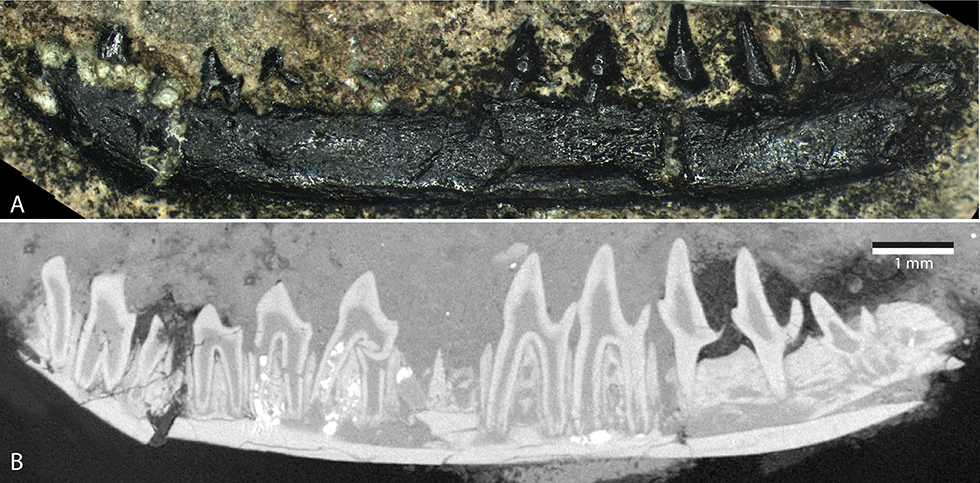The discovery of a tiny, 170-million-year-old fossil on the Isle of Skye has led Oxford University researchers to conclude that three previously recognised species are in fact just one.
During a fossil-hunting expedition in Scotland last year, a team of researchers from the University's Department of Earth Sciences discovered the fossilised remains of a mouse-sized mammal dating back around 170 million years to the Middle Jurassic period. The new find – a tiny lower jaw bearing 11 teeth – shows that that three species previously described on the basis of individual fossilised teeth actually belong to just one species.
The United Kingdom has yielded many important mammalian fossils from the Middle Jurassic, a period dating between 176 and 161 million years ago, with most being found in the Scottish Isles and around Oxfordshire. Indeed, specimens obtained from Kirtlington Quarry – just 10 miles north of Oxford – have provided some of the richest Middle Jurassic mammal records to date. Included among those are a large number of teeth, each found in isolation, that had been thought to include at least three distinct species of what are known as ‘stem therians’ – ancient relatives of many modern mammals, including rodents and marsupials.
Now, though, the team from Oxford has discovered a fossil which refutes those claims. The team found the 10 millimetre-long fossilised jaw at a site on the west coast of the Isle of Skye. 'We spent five days exploring the locality, finding nothing especially exciting, and were walking back along the beach to the house where we were staying,' recalls Dr Roger Close, the lead author of the study. 'Then, by chance, we spotted this specimen on the surface of a boulder.'
After carefully removing the specimen – a complete left lower jaw of a small mammal – the team carried out a series of analyses to determine its origins. First, they performed a high-resolution x-ray CT scan at the Natural History Museum in London, providing an incredibly detailed 3D model of the fossil that allowed the researchers to glean much more information about its anatomy than could ever be possible by visual inspection. 'Over half of the fossil is still buried in the rock,' explains Dr Close. 'The CT scan allows us to virtually remove this, and explore the whole specimen in exquisite detail.'
From there, they systematically compared the shape of each and every tooth present in the jaw to those found in all similar specimens discovered in the past. They were surprised to find that the new jaw resembled not one species, but three: Palaeoxonodon ooliticus, Palaeoxonodon freemani and Kennetheridium leesi, all known from isolated teeth preserved in rocks of the same age from Oxfordshire.
Differences in tooth shape that had been thought to distinguish three different species were in fact all present in the single lower jaw found on the Isle of Skye. 'In effect, we've "undiscovered" two species,' explains Dr Close. 'The new find shows that we should be cautious about naming new types of animals on the basis of individual teeth.' In a paper published in Palaeontology, the team identifies their find as Palaeoxonodon ooliticus – the name given to the first of the three species to be described back in the late 1970s.
Palaeoxonodon has long been recognised as an important species for understanding the evolution of molar teeth in modern mammals, and this latest discovery sheds more light on the subject. The species appears to show an intermediate step in the evolution of what are known as ‘tribosphenic’ molars – a kind of pestle-and-mortar geometry that is particularly well suited to processing food.
'Towards the front, three sharp cusps allow the animal to slice up the food, while at the back a flatter, grinding surface crushes it,' explains Dr Close. 'It's an evolutionary innovation that allowed much more versatile ways of feeding to evolve, and it may well have contributed to the long-term success of this group of mammals.'
